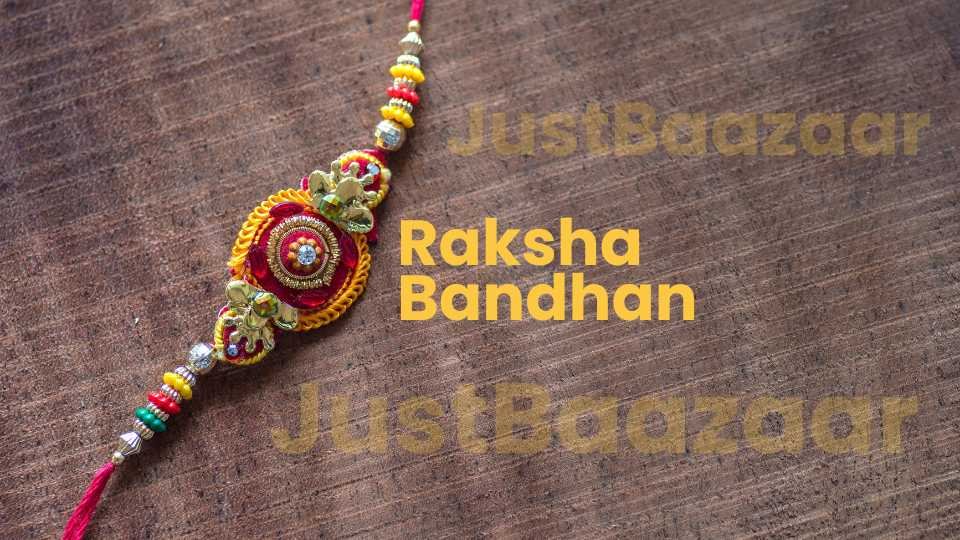Rakshabandhan, often referred to as Rakhi, is a cherished festival celebrated predominantly in India and among Indian communities worldwide. It signifies the bond between brothers and sisters, symbolizing protection, love, and care. Here’s a comprehensive exploration of Rakshabandhan, including its history, origin, legends, celebration methods, and its importance.

1. Origin and History
Origin: The festival of Rakshabandhan is believed to have ancient roots in Hindu tradition. The word “Rakshabandhan” translates to “the bond of protection.” It is celebrated on the full moon day (Purnima) of the Hindu lunar month of Shravan (usually August).
Historical Background: Rakshabandhan’s origins are often linked to various historical and mythological events in Indian culture. Though the exact historical roots are debated, several ancient texts and stories highlight the festival’s significance and evolution over time.
2. Legends and Stories
1. The Story of Queen Kunti and King Yudhishthira: One of the popular legends associated with Rakshabandhan is the tale of Queen Kunti and her sons from the Mahabharata. Queen Kunti, the mother of the Pandavas, is said to have tied a rakhi (sacred thread) around King Yudhishthira’s wrist, seeking his protection. In response, King Yudhishthira promised to safeguard her sons from all harm.
2. The Legend of Rani Karnavati and Emperor Humayun: Another famous story is about Rani Karnavati of Chittor and the Mughal Emperor Humayun. Facing a threat from Bahadur Shah, Rani Karnavati sent a rakhi to Humayun, seeking his help. Touched by her gesture, Humayun set out to help her, demonstrating the festival’s importance in invoking protection and solidarity.
3. The Story of Lord Vishnu and Goddess Laxmi: In a mythological context, the story of Lord Vishnu and Goddess Laxmi also highlights Rakshabandhan. When Goddess Laxmi wanted to ensure Lord Vishnu’s protection, she tied a rakhi on his wrist. In return, Vishnu promised to grant her protection and favor.
3. How to Celebrate Rakshabandhan
Preparation:
- Rakhi Selection: Choose a beautiful rakhi, which could be a traditional thread or one embellished with pearls, stones, or intricate designs.
- Gifts: Prepare thoughtful gifts for brothers. These can range from traditional sweets and snacks to modern gadgets or personalized items.
- Pooja Thali: Prepare a pooja thali (ceremonial plate) with a diya (lamp), roli (vermilion), chawal (rice), sweets, and the rakhi.
Celebration:
- Rituals: On Rakshabandhan, sisters tie a rakhi on their brothers’ wrists, performing a small puja (prayer ceremony) to invoke blessings. The ritual involves applying a tilak (vermilion mark) on the brother’s forehead, followed by the tying of the rakhi.
- Exchange of Gifts: Brothers give gifts to their sisters as a token of their appreciation and affection. This can include money, jewelry, or other valuable items.
- Feasting: Families come together to celebrate with festive meals, sharing traditional sweets and snacks.
- Family Bonding: The festival is an occasion for family gatherings, reinforcing the bond between siblings and relatives.
4. Importance and Significance
Symbol of Protection: Rakshabandhan symbolizes the protective bond between siblings. The rakhi represents a sister’s love and prayers for her brother’s safety and well-being, while the brother promises to stand by her and protect her.
Strengthening Family Bonds: The festival strengthens familial relationships and enhances the sense of unity and togetherness among family members. It provides an opportunity for families to reconnect and celebrate their shared heritage.
Cultural Tradition: Rakshabandhan is deeply embedded in Indian culture, reflecting the values of love, respect, and mutual support. It is celebrated with enthusiasm across various communities, reflecting the rich cultural tapestry of India.
Promoting Gender Equality: In modern times, Rakshabandhan also promotes the idea of gender equality and mutual respect. It highlights the importance of both brothers and sisters supporting and caring for each other, transcending traditional roles and expectations.
5. Contemporary Celebrations
In contemporary times, Rakshabandhan has evolved beyond traditional practices. It is now celebrated with modern twists, including:
- Virtual Celebrations: For siblings separated by distance, virtual rakhi tying ceremonies and online gift exchanges have become popular.
- Charitable Acts: Some people observe Rakshabandhan by engaging in charitable activities or supporting social causes, spreading the festival’s spirit of care and protection beyond familial bonds.
Conclusion
Rakshabandhan is more than just a festival; it is a celebration of the enduring bond between brothers and sisters. Its rich history, legendary stories, and significance reflect the values of love, protection, and familial unity. Whether through traditional rituals or modern adaptations, Rakshabandhan continues to be a cherished occasion that brings families together and strengthens relationships.
How to Celebrate Rakshabandhan?
Rakshabandhan, also known as Rakhi, is a joyous festival that celebrates the bond between brothers and sisters. The celebration involves various customs and traditions that can vary based on regional practices and personal preferences. Here’s a comprehensive guide on how to celebrate Rakshabandhan:
1. Pre-Celebration Preparations
1.1. Select and Buy Rakhi:
- Traditional Rakhi: Choose a traditional rakhi made of silk threads, often adorned with embellishments like beads, sequins, and pearls.
- Personalized Rakhi: Consider rakhis with personalized elements such as names, initials, or photographs.
- Themed Rakhis: For a fun twist, pick rakhis with themes related to your brother’s interests, such as superheroes or sports.
1.2. Purchase Gifts:
- For Brothers: Gifts can include traditional items like sweets, clothes, or accessories. Modern gifts might be gadgets, books, or personalized items.
- For Sisters: Brothers usually give gifts to their sisters as a token of appreciation. Choose thoughtful gifts that reflect her tastes and preferences.
1.3. Prepare Pooja Thali:
- Essential Items: Arrange a pooja thali with a diya (lamp), roli (vermilion), chawal (rice), sweets, and the rakhi.
- Decorations: Decorate the thali with flowers and colorful rangoli designs if desired.
1.4. Clean and Decorate the Home:
- Clean the Space: Ensure that the area where the celebration will take place is clean and tidy.
- Decorate: You can use colorful decorations, lights, and festive items to create a cheerful atmosphere.
2. Rakshabandhan Day Rituals
2.1. Perform the Rituals:
- Gather Family: Bring together family members for the celebration. It’s often a time for family reunions and gatherings.
- Place the Thali: Set up the pooja thali in a clean and central location.
- Apply Tilak: Begin the ceremony by applying a tilak (vermilion mark) on your brother’s forehead.
- Tie the Rakhi: Carefully tie the rakhi on your brother’s wrist, while reciting a prayer or wish for his well-being and success.
- Offer Sweets: Feed your brother a sweet (such as mithai or chocolate) as part of the ritual.
2.2. Exchange Gifts:
- Give Gifts: Present the gifts you have prepared for your brother.
- Receive Gifts: If you’re a brother, give a gift to your sister as a token of your love and appreciation.
2.3. Celebrate Together:
- Feast: Enjoy a festive meal together. Traditional dishes and sweets are usually prepared for the occasion.
- Family Time: Spend quality time with family members, sharing stories, and participating in family activities.
3. Modern Adaptations and Virtual Celebrations
3.1. Virtual Rakhi:
- Video Calls: For siblings separated by distance, arrange a video call to perform the rakhi tying ceremony virtually.
- Online Shopping: Order a rakhi online and have it delivered to your brother’s or sister’s address.
- Digital Gifts: Exchange e-gift cards, online vouchers, or digital greetings.
3.2. Charitable Acts:
- Community Support: Celebrate Rakshabandhan by engaging in charitable activities such as donating to orphanages, supporting underprivileged communities, or contributing to social causes.
- Spread Joy: Participate in or organize events that help spread joy and kindness, reflecting the festival’s spirit.
4. Post-Celebration Customs
4.1. Thank You Notes:
- Express Gratitude: Send thank you notes or messages to family members who joined the celebration or sent gifts.
4.2. Clean-Up:
- Tidy Up: After the festivities, clean up the area where the celebration took place, including the pooja thali and any decorations.
4.3. Preserve Memories:
- Photographs: Take photographs of the celebration to preserve memories of the special day.
- Share on Social Media: If you’re comfortable, share your Rakshabandhan moments on social media to connect with friends and extended family.
Rakshabandhan, also known as Rakhi, is a vibrant and joyous festival celebrated in India. It holds a special place in the hearts of millions of people across the country. This auspicious occasion is dedicated to the bond between brothers and sisters, celebrating their love, protection, and lifelong commitment to each other. The festival falls on the full moon day of the Hindu month of Shravana (July-August) and is eagerly awaited by siblings every year.
The significance of the festival in strengthening the bond between brothers and sisters:
Rakshabandhan holds tremendous significance in strengthening the bond between brothers and sisters. It is a day when siblings come together to express their love, respect, and gratitude for each other. Sisters tie a sacred thread called “rakhi” around their brothers’ wrists as a symbol of protection, while brothers pledge to safeguard their sisters’ well-being throughout their lives. This exchange represents an unbreakable bond filled with trust, devotion, and affection.
Exploring the historical origins of Rakshabandhan and its connection to Hindu mythology:
Rakshabandhan has deep roots in Hindu mythology. One such legend that resonates with this celebration involves Indra Dev (the king of gods) and his wife Sachi Devi. According to ancient scriptures, there was once a fierce battle between gods (devas) led by Indra Dev and demons (asuras) threatening peace in heaven.
Detailing the challenges faced by Indra Dev during this battle:
The demons had gained immense power through rigorous penance conducted by King Bali’s grandson Prahlada. They launched an attack on heaven under Prahlada’s commandment which posed great danger for Indra Dev.
Sachi Devi’s role in protecting Indra Dev:
Sachi Devi, witnessing the plight of her husband, sought divine intervention. She approached Lord Vishnu seeking his help to protect Indra Dev from the impending danger. Lord Vishnu granted Sachi Devi a sacred thread and advised her to tie it around Indra’s wrist as a symbol of protection.
The symbolism behind this act of love, trust, and devotion:
Sachi Devi’s act of tying the sacred thread around Indra’s wrist symbolized her love, trust, and unwavering devotion towards him. It served as a reminder to Indra that he was not alone in his struggles and that he had someone who would always stand by his side.
Drawing parallels between this legendary bond and the bond celebrated during Rakshabandhan:
This legendary bond between Indra and Sachi Devi draws parallels with the bond celebrated during Rakshabandhan. Just as Sachi protected Indra with her sacred thread, sisters tie rakhi on their brothers’ wrists to seek their love, support, and protection.
Highlighting how this legend emphasizes standing up for loved ones through thick and thin:
The legend behind Rakshabandhan teaches us the importance of standing up for our loved ones through thick and thin. It reminds us that true relationships are built on love, trust, loyalty, and unwavering support.
Concluding reflections on how understanding this legend can deepen one’s appreciation for Rakshabandhan:
Understanding the legend behind Rakshabandhan deepens our appreciation for this beautiful festival. It reminds us of the significance of family bonds in our lives and encourages us to cherish our relationships with siblings. Just as Sachi Devi stood by Indra’s side when he needed her most, Rakshabandhan serves as a reminder to always be there for one another in times of joy or adversity.
By delving into the historical origins of Rakshabandhan and exploring the legend of Indra Dev and Sachi Devi, we gain a deeper understanding of the festival’s essence. Rakshabandhan is not just a day of celebration but also an opportunity to reflect on the timeless values of love, protection, and devotion that unite us as siblings
The Legend Behind Rakshabandhan: Indra Dev and Sachi Devi’s Sacred Bond
Introduction:
Rakshabandhan, also known as Rakhi, is a festival celebrated with great enthusiasm in India. It is a significant occasion that strengthens the bond between brothers and sisters. This chapter delves into the legendary story behind Rakshabandhan, featuring Indra Dev, the king of gods, and his wife Sachi Devi. Their sacred bond serves as a beautiful metaphor for the love, trust, and devotion shared between siblings during this auspicious festival.
The Challenges Faced by Indra Dev:
In ancient times, heaven was threatened by powerful demons who sought to disturb its peace. Indra Dev took upon himself the responsibility of protecting heaven and its inhabitants from these malevolent forces. However, he faced numerous challenges during this battle for righteousness.
Sachi Devi’s Divine Protection:
As Indra Dev prepared for his arduous battle against the demons, Sachi Devi recognized her husband’s vulnerability and feared for his safety. In an act of unwavering love and devotion, she decided to protect him by tying a sacred thread around his wrist. This thread symbolized her divine protection and served as a talisman against any harm that might befall him.
Symbolism of Love and Trust:
The act of Sachi Devi tying the sacred thread around Indra Dev’s wrist holds deep symbolism in Rakshabandhan celebrations. It represents not only love but also trust between siblings or loved ones. Just as Sachi Devi had faith in her ability to safeguard her husband from danger, brothers too promise to protect their sisters from all harm when they accept the rakhi tied on their wrists.
Parallel Between Legends and Celebrations:
The legend of Indra Dev and Sachi Devi beautifully parallels the celebration of Rakshabandhan between brothers and sisters. It emphasizes the importance of standing up for loved ones, even in the face of adversity. Just as Sachi Devi protected Indra Dev during his battle, sisters tie rakhis on their brothers’ wrists as a symbol of their love, trust, and belief in their protective instincts.
Standing Up for Loved Ones:
The legend behind Rakshabandhan teaches us the value of loyalty and sacrifice for those we hold dear. It reminds us that bonds between siblings transcend mere blood relations and are strengthened by love, trust, and protection. Brothers pledge to shield their sisters from harm while sisters pray for the well-being and success of their brothers.
Reflections on Rakshabandhan’s Significance:
Understanding this legendary tale deepens our appreciation for Rakshabandhan as more than just a traditional festival. It highlights its profound significance in promoting strong family ties and fostering a sense of unity among siblings. The act of tying a rakhi becomes not only an expression of love but also a promise to protect one another throughout life’s journey.
Conclusion:
As we reflect on the legend behind Rakshabandhan, we realize that it transcends time and cultural boundaries. The story of Indra Dev and Sachi Devi serves as a universal symbol of love, trust, and protection that resonates with people from all walks of life. By honoring this sacred bond through the celebration of Rakshabandhan, we embrace our own roles as protectors and nurturers within our families.
In the next chapter: “Tracing Back History: Origins of Rakhi Tying Rituals,” we will explore how this ancient festival has evolved over time while retaining its core traditions. We will delve into early references to rakhi tying rituals in ancient Indian scriptures and texts, uncovering how social, religious, and historical contexts have shaped Rakshabandhan into what it is today
Tracing Back History: Origins of Rakhi Tying Rituals
Introduction:
Rakshabandhan, also known as Rakhi, is a festival celebrated with great enthusiasm in India. This joyous occasion brings brothers and sisters together to strengthen their bond and express love and protection for each other. In this chapter, we will delve into the historical origins of the rakhi tying rituals that are an integral part of Rakshabandhan. By tracing back the roots of these rituals, we can gain a deeper understanding of their significance and how they have evolved over time.
Early References in Ancient Indian Scriptures:
The practice of tying rakhis dates back centuries and finds mention in ancient Indian scriptures and texts. The Rigveda, one of the oldest religious texts in the world, makes references to raksha or protection. The concept of offering protection through sacred threads is deeply ingrained in Hindu mythology. These early references lay the foundation for understanding how Rakshabandhan came to be associated with love and protection.
Evolution of Rituals:
Over time, rakhi tying rituals have evolved to incorporate various cultural influences and regional variations. Different parts of India have their unique customs associated with Rakshabandhan. For example, in some regions, sisters tie rakhis not only on their brothers’ wrists but also on trees or idols as a means to seek blessings for their well-being. These diverse practices showcase the rich tapestry of traditions that contribute to the celebration of Rakshabandhan.
Significance of Rakhi:
The rakhi itself holds deep symbolism in this festival. Made from colorful threads embellished with beads or decorative elements, it represents love and protection between siblings. The thread symbolizes an unbreakable bond that transcends distance or time – a reminder that brothers will always be there for their sisters when they need them.
Social, Religious, and Historical Contexts:
To truly appreciate Rakshabandhan, we must consider the social, religious, and historical contexts that have shaped its traditions. In Hindu mythology, Lord Krishna’s relationship with his sister Draupadi exemplifies the essence of Rakshabandhan. When Draupadi tore a strip of cloth from her own saree to tend to Krishna’s wound, he promised to protect her always. This story highlights the selflessness and sacrifice that encapsulate the festival.
Furthermore, Rakshabandhan also holds historical significance. During the Indian independence movement in the early 20th century, rakhis were used as symbols of unity and resistance against British rule. Prominent leaders like Rabindranath Tagore encouraged women to tie rakhis on men’s wrists as a symbol of solidarity and protection.
Unity Among Diverse Communities:
While Rakshabandhan is deeply rooted in Hindu culture, it has transcended its traditional boundaries and become a celebration of unity among diverse communities. In modern times, people from different religions and backgrounds come together to celebrate this festival. It serves as a reminder that love and protection are universal values that bind us all.
Preserving Cultural Heritage:
The power of tradition lies in its ability to foster connections across generations while preserving cultural heritage. As we celebrate Rakshabandhan year after year, we not only honor our siblings but also strengthen our ties with our roots. By understanding the historical origins of rakhi tying rituals, we can ensure that these traditions continue to thrive in an ever-changing world.
Conclusion:
Tracing back the history of rakhi tying rituals allows us to appreciate their significance within the context of Rakshabandhan. From ancient scriptures to regional variations and historical events, each element contributes to the rich tapestry surrounding this festival. As we tie rakhis on our brothers’ wrists or extend this gesture beyond biological siblings, let us remember that Rakshabandhan is a celebration of love, protection, and the enduring bonds that connect us all
Stories Behind the Threads: Tales of Love and Loyalty
Introduction:
In this chapter, we delve into the rich tapestry of stories associated with Rakshabandhan from various parts of India. These stories exemplify the timeless themes of sibling love, sacrifice, bravery, and loyalty. They not only showcase the unique bond between brothers and sisters but also highlight how rakhi has been used as a means to seek protection beyond conventional relationships. Through these narratives, we discover universal truths that resonate with people from all walks of life.
The Power of Sibling Love:
One such story revolves around Rani Karnavati of Chittorgarh and Emperor Humayun. When Chittorgarh was under attack, Rani Karnavati sent a rakhi to Emperor Humayun seeking his protection for her kingdom and her people. Touched by her plea, Humayun immediately set off to defend Chittorgarh. Although he arrived too late to save the queen, this tale showcases the power of sisterly love that transcends boundaries.
Another remarkable tale is that of King Bali and Goddess Lakshmi. According to Hindu mythology, during a battle between gods and demons, Goddess Lakshmi tied a rakhi on King Bali’s wrist seeking his protection for Lord Vishnu who had taken on the form of Vamana (a dwarf). Impressed by her devotion, King Bali granted Vishnu’s request without hesitation. This story symbolizes not only sibling love but also loyalty towards one’s duty.
Historical Figures Bound by Rakhi:
In addition to these mythological tales, history is replete with instances where rakhi played a significant role in shaping events. One such example is that of Alexander the Great and King Puru (Porus) in ancient India. After being defeated in battle by Alexander, King Puru was about to be executed when he noticed a rakhi on his wrist. Touched by the gesture, Alexander spared Puru’s life and acknowledged their bond as brothers.
Similarly, during the revolt of 1857 against British rule in India, Rani Laxmi Bai tied rakhis on the wrists of fellow Indian soldiers, symbolizing their shared commitment to fight for freedom. These stories highlight how rakhi has been a source of inspiration and unity during pivotal moments in history.
Beyond Sibling Relationships:
Rakshabandhan is not limited to blood relationships alone; it extends to chosen family and friends as well. A heartwarming story from Gujarat tells us about a Muslim man named Abdul Kadir who tied a rakhi on his Hindu friend Rajubhai’s wrist. This act exemplifies the inclusive spirit of Rakshabandhan, where people come together irrespective of religious or cultural differences to celebrate love and protection.
Another tale hails from West Bengal, where widows tie rakhis on the wrists of priests at temples, seeking their blessings and protection. This tradition challenges societal norms by recognizing the power that women hold in fostering love and connection beyond traditional roles.
Universal Themes:
These stories behind the threads resonate with people across cultures because they touch upon universal themes like love, loyalty, sacrifice, and courage. They remind us that our bonds with loved ones go beyond physical distance or societal constructs. Rakshabandhan serves as a reminder to cherish these connections and protect them fiercely.
Conclusion:
The stories associated with Rakshabandhan are not mere legends but timeless reminders of what it means to be human – to love unconditionally, protect fiercely, and stand by our loved ones through thick and thin. They inspire us to cherish our own relationships during this auspicious festival while also extending our love beyond conventional boundaries. By embracing these stories behind the threads that tie us together, we honor the true essence of Rakshabandhan – a celebration of love, loyalty, and the eternal bond between brothers and sisters.
The Modern Celebration: Reviving Traditions for Today’s World
Introduction:
Rakshabandhan, a festival deeply rooted in Indian culture, has evolved over time to adapt to the changing dynamics of modern life. In this chapter, we will explore how individuals have embraced contemporary trends while honoring the rich traditions associated with Rakshabandhan. From personalized rakhis to virtual celebrations for distant siblings, this chapter delves into the ways in which this age-old festival continues to thrive in today’s world.
Adapting to Modern Sensibilities:
As technology advances and families become more geographically dispersed, celebrating Rakshabandhan has taken on a new dimension. In addition to traditional in-person gatherings, many people now opt for virtual celebrations. Through video calls and online platforms, siblings separated by distance can still partake in the rituals of tying rakhi and exchanging gifts. This modern approach allows families to bridge the gap between physical distances and ensures that the essence of Rakshabandhan is not lost.
Infusing New Meaning into Tradition:
While preserving tradition is important, it is equally vital to infuse new meaning into festivals like Rakshabandhan. Many individuals have begun personalizing rakhis by incorporating elements that reflect their unique bond with their siblings. Handmade rakhis adorned with favorite colors or symbols hold sentimental value and serve as a reminder of shared memories.
Gender Inclusivity:
Rakshabandhan has traditionally portrayed sisters tying rakhis on their brothers’ wrists as a symbol of protection and love. However, in today’s world where gender roles are evolving rapidly, there is room for inclusivity within this celebration. Sisters can also tie rakhis on their sisters’ wrists or even vice versa – brothers can tie rakhis on each other’s wrists as a demonstration of love and support.
Extending Bonds Beyond Biological Siblings:
In an ever-changing society, the definition of family has expanded to include chosen family and close friends. Rakshabandhan offers a wonderful opportunity to extend the bonds of love and protection beyond biological siblings. Friends who have stood by each other through thick and thin can tie rakhis, symbolizing their commitment to each other’s well-being. This inclusive approach allows Rakshabandhan to become a celebration of all meaningful relationships, regardless of blood ties.
Cherishing and Protecting All Loved Ones:
While Rakshabandhan traditionally focuses on the bond between brothers and sisters, its essence goes beyond familial relationships. It is a reminder for individuals to cherish and protect all loved ones in their lives. Whether it is parents tying rakhis on their children’s wrists or grandparents embracing their grandchildren with affection, the festival serves as a gentle nudge towards nurturing all connections that bring joy and support.
Thriving in an Ever-Changing World:
Rakshabandhan has successfully adapted to various cultural shifts throughout history. Its ability to transcend time and distance is evident in its continued celebration across diverse communities around the world. As we navigate an era of globalization, where traditions can sometimes feel diluted or lost, Rakshabandhan holds steadfast as a symbol of unity within families and communities.
Conclusion:
In this chapter, we explored how Rakshabandhan has evolved to suit modern sensibilities while preserving its rich traditions. From virtual celebrations that bridge geographical gaps to personalized rakhis that reflect unique bonds, this festival continues to thrive by embracing change while staying true to its essence. By promoting inclusivity, cherishing all loved ones, and fostering connections that transcend traditional boundaries, Rakshabandhan remains an important reminder of love, protection, and unity in today’s ever-changing world.
Throughout this book titled “Rakshabandhan: How to Celebrate Rakshabandhan – Legend Stories History Origin Importance,” we have delved into the significance of Rakshabandhan as a festival that celebrates love, protection, and harmony. From exploring its historical origins and legends to understanding the rituals and customs associated with it, we have unraveled the beauty of this festival. By reviving traditions for today’s world, Rakshabandhan continues to hold a special place in our hearts, reminding us of the power of love and the importance of fostering connections with our loved ones




















